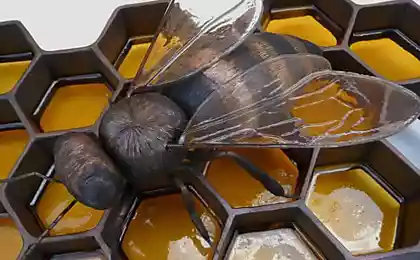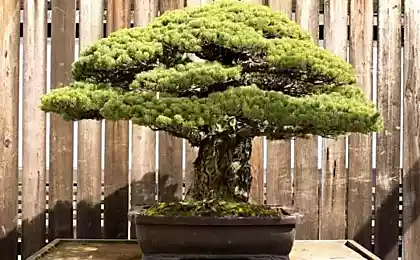123
Why are bonsai roots and honeycombs in the form of hexagons?

Nature is the greatest mathematician and engineer who created perfect forms long before human civilization. The hexagon, this simple geometric figure, is found everywhere, from tiny honeycombs to complex bonsai root systems, from the structure of snowflakes to basalt columns in Ireland. What makes this form so versatile, and why did nature choose it for a variety of tasks?
Mathematical magic of the hexagon
The hexagon has unique properties that make it an ideal solution for many natural applications. Its main feature is that it provides the maximum area with a minimum perimeter among all regular polygons that can fill the plane without spaces.
The honeycomb theorem, proved by mathematician Thomas Hales in 1999, states that a hexagonal grid is the most efficient way to divide a plane into equal areas with a minimum perimeter. This means that the least amount of building material is required to create a certain volume.
Imagine if bees built their honeycombs in the shape of squares, they would need 15% more wax. Round cells would be even less efficient, and triangular cells would be too sharp to accommodate the larvae comfortably.
Architectural masterpieces of the bee kingdom

Bee honeycombs are an engineering marvel that humanity is just beginning to understand. Each cell is tilted at an angle of 13 degrees to the horizon, which prevents honey from leaking out. The wall thickness is only 0.073 millimeters, but the design is able to withstand a weight 25 times its own.
The amazing fact is that bees are not born with blueprints for perfect hexagons in their heads. They begin to build round cells, but under the influence of the body temperature of the bees (about 35 ° C), the wax softens and takes the most energetically advantageous form - hexagonal.
Working bees use their own bodies as living measuring instruments. The distance between their spread wings determines the size of the cell, and their weight helps create walls of the desired thickness. This biological compass works to within a fraction of a millimeter.
Secrets of the Bonsai Root System
The art of bonsai, which originated in China more than a thousand years ago, has revealed another mystery of nature. The root system of miniature trees often forms hexagonal patterns, especially noticeable when viewed from above at the root system in shallow containers.

This phenomenon is explained by the same optimization principles as bee honeycombs. Roots strive to make the most of the limited container space by evenly distributing nutrients throughout the soil.
Bonsai master John Naka said, “When you look at the roots of an old tree, you see the mathematics of nature in its purest form.” Every bend, every branch, follows laws which man has discovered for thousands of years.
Stress as a factor of formation
The limited space of the container creates a special kind of stress for the root system. In response, the plant activates ancient genetic programs, forcing the roots to find the most effective ways to grow. Hexagonal patterns arise as a result of competition for resources between neighboring roots.
The Universal Language of Nature
Hexagons are found not only in beehives and bonsai roots. This form permeates all of nature:

Basalt columns in the Giant's Road in Ireland form hexagonal structures as lava slowly cools. Snowflakes form six-pointed stars due to the crystalline structure of the ice. Even some clouds on the planet Saturn are hexagonal in shape.
Scientists from Harvard University found that hexagonal patterns occur in systems where the forces of surface tension and energy minimization operate. This explains why soap bubbles on the surface of the water also tend to take on a hexagonal shape.
Practical applications of natural principles
For gardeners and bonsai lovers:
Understanding the principles of hexagonal growth will help you better shape your root system. When transplanting bonsai, place the main roots at an angle of 60 degrees to each other – this will create the most stable and effective nutrition system.
Use hexagonal base containers for young plants. This form stimulates the uniform development of the root system and prevents the twisting of the roots.
For architects and designers:
The hexagonal layout of the premises provides maximum functionality with minimal costs for construction materials. Japanese architects actively use this principle when designing energy efficient buildings.
When creating storage systems or logistics centers, the hexagonal grid allows you to increase the usable area by 15-20% compared to the square layout.
The Future of Hexagonal Technology
Modern technologies are increasingly turning to natural principles. Engineers create ultralight materials with a hexagonal structure, which are used in aviation and astronautics. Such materials have the highest strength with minimal weight.
Researchers at MIT have developed robot bees capable of building hexagonal structures to create temporary shelters on other planets. These robots use the same collective building principles as real bees.
The hexagon is not just a geometric figure, but a universal efficiency code written in the very DNA of nature. From microscopic honeycombs to complex bonsai root systems, we see the same principle: maximum functionality with minimal input. By exploring these natural solutions, we not only gain a better understanding of the world around us, but also find inspiration to create better technologies for the future.
Glossary of terms
The comb theorem The mathematical statement that a hexagonal grid is the most efficient way to divide a plane into equal areas with a minimum perimeter.
Biological compass The ability of living organisms to use parts of their bodies as measuring tools to create precise designs.
Surface tension A phenomenon in which the surface of a liquid tends to take shape with a minimum area.
Energy optimization A process in which a system seeks to achieve a state with minimal energy expenditure.
Basalt columns - vertical stone formations, formed with slow cooling of lava and forming characteristic hexagonal structures.
crystalline structure The orderly arrangement of atoms or molecules in a solid that determines its physical properties.
8 Healthy Lifestyle Ideas That Are Easily Included In Your Schedule
Jung's Random Nonrandomness: The Synchronicity and Magic of Number 4























